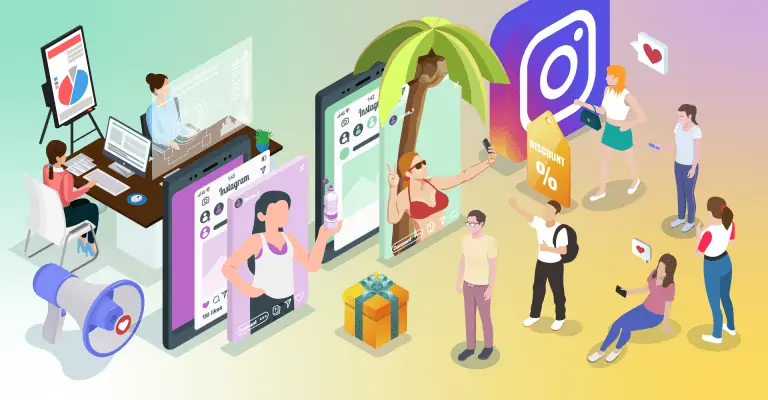
A decade ago, only a small number of devoted bloggers and famous people participated in influencer marketing. The rise of social media influencers, their saturation of the market, and even their involvement in fraud seem to have occurred recently.
Suppose you’ve looked into influencer marketing before. In that case, you may have come across conflicting advice, with suggestions ranging from using social influencers without a doubt to saying they’re not vital for growth. As a brand, navigating influencer marketing methods is more challenging than ever, but we’re here with a guide to help you make sense of it all.
What is influencer marketing?
Influencer marketing, at its core, is a form of social media promotion that relies on recommendations and mentions of products from influencers—people who have a sizable social following and are recognized as authorities in their field.
Influencer marketing is effective because social influencers have established a high level of trust with their followers, and their recommendations provide social evidence to potential customers for your business.
What works in Influencer Marketing
Think very carefully about how you will use influencer marketing.
- Be organized, create a plan, budget, and strategy, and invest time in research.
- Choose your design for locating influencers. Find them naturally, sign up for a platform, or use an agency.
- Be kind and patient; remember that people are talking to people, not businesses.
Develop a schedule
- Does the influencer prefer monthly/quarterly/biannual calls or newsletters?
- Integrate with your PR schedule, product release schedule, etc.
- Send emails on behalf of key executives. Plan travel schedules for executives and arrange face-to-face meetings.
Influencer marketing’s value

Although Instagram influencer marketing is a well-known tactic, influencers are also increasingly using other networks. By 2020, the sector is anticipated to be worth $10 billion, according to Adweek.
Other social media platforms with diverse demographics, such as Snapchat, YouTube, and TikTok, each have their own set of influencers. At the end of 2018, the influencer marketing firm Mediakix polled marketers to find out how they felt about influencers in 2019.
89% of those polled stated that the ROI from influencer marketing was on par with or even superior to that of other networks. According to the same report, 65% of marketers anticipate raising their spending in 2019. And now that you are aware of the state of the market let’s look at how to develop an influencer plan.
How to create an influencer marketing strategy
An influencer program requires thoughtful planning and targeting, just like any other marketing strategy.
Sending free stuff to everyone who asks or to your current friends and acquaintances won’t lead to strategic success.
1. How to find influencers and what to pay them
Research is the initial stage, just like with any approach. Pick the platform on which you want to concentrate first. Expanding to additional platforms is always an option, but if you’re starting, stay with one.
Your company should ideally already be active on this network or be planning to do so. If you don’t know where to start, social listening can help you find the platforms where people are talking about your brand and sector and the most influential people there. For more information, see our guide on social listening.
When you intend to use an influencer marketing strategy, the sector you work in also counts.
On YouTube and Instagram, beauty and fashion firms are prominent. On Twitch, the video game industry rules. Look into the influencers you’re interested in during the research step.
Are you aiming for well-known figures with large fan bases? Or micro-influencers who have fewer than 2,000 fans?
You might want something in the middle, with 5 to 10k followers. Your budget will be determined by what you choose to concentrate on.
Additionally, compensation varies greatly, so check out standard rates for particular influencer categories. Micro-influencers typically accept items and are narrowly focused on a few topics.
While some micro-influencers operate alone, others might be affiliated with a network or agency. Larger accounts and celebrities, however, may require payment and even go through a talent agency.
You’ll need to consider your social influencer marketing plan’s projected return on investment (ROI). How will you determine how much the influencer postings contributed to your overall marketing objectives?
The price for a video production company to work on making an advertisement for you versus an influencer creating a video may be compared to your expectations for influencers as one strategy.
Although it may appear at first that determining the worth of influencers is uncertain, this method will provide you with a convenient basis for comparison and contrast.
2. Set a budget and management strategy
You need to make your budget now that you have a general concept of what to pay influencers. Don’t forget to account for the time required for influencer program conception, implementation, and evaluation. Successful influencer marketing campaigns don’t just happen. They require planning and execution.
Careful monitoring and follow-up will be required. Contrary to a more automated marketing campaign, influencers are human and sometimes juggle several collaborations, so some may forget to post on schedule or make mistakes with the tags or calls to action you requested.
You’ll need to make the time to spend more time cultivating these relationships and hone your strategy as you learn what works and what doesn’t in your specialized market.
If you have the resources, think about establishing a formal ambassador program. Fujifilm uses its brand ambassadors to promote new products and enhance its content.
The company can diversify its feed to show off the capabilities of its technology because they have a variety of photographers and videographers at its disposal.
Hiring a marketing agency that specializes in influencers is a smart move for brands that require access to a larger pool of influencers.
- Select your objectives and messaging
The two most frequent goals of influencer marketing are to raise brand recognition and boost sales.
However, it will be more productive to begin your plan by focusing on your brand’s requirements rather than making these two broad objectives your two aims. Perhaps you want to attract more young people as customers.
Or perhaps you want to introduce a new product to a new consumer base. You might also use influencers to promote your brand principles instead of following trends.
Influencers can connect with highly niche audiences. Influencers will assist you in making sure a very targeted audience that is likely to be interested in your product reads and engages with your content rather than relying on thousands of followers.
Influencer posts are easier to distinguish from the kinds of features- or sales-driven posts a business would make for the same product on their page when they have a conversational tone and a personal narrative.
Your aim and message should be equally significant. You don’t want an influencer to post about something unrelated to your brand, but you don’t want to inhibit their creativity and individuality.
Make a plan to organize your influencer marketing strategy and message so you can adhere to it later.
- Outreach to influencers: How to get in touch with them
Returning to step one, research
We return to our research on how to discover the ideal influencers to work with once we have a plan in place that takes into account your network, goals, and the types of influencers you want to target.
Throughout this inquiry, have the following in mind:
Does the influencer currently provide content that is similar to what you offer? For instance, if you own a restaurant and want to advertise a new menu, you can seek out influencers who frequently blog about their dining experiences and diets.
They’re honest. This entails swiping through their feed and selecting posts. A phony account will have a low engagement to follower ratio and spam-like remarks.
Have they already worked with brands like mine? An experienced influencer can offer you a press kit that includes a portfolio of their work, depending on the kind of influencer you’re looking for. You’ll want to check out an influencer more the more you invest in them.
Additionally, you can find potential influencers who can benefit your efforts by using Twitter analytics tools.
Next, choose your strategy for contacting them. On the same site, you could send a private message to micro-influencers to contact them directly.
If you click on the profile of a more seasoned one, their bio may contain contact information for business inquiries. They could also include a link to a website that indicates brand alliances.
For her brand partners, Summer Rayne Oakes’ multi-channel presence is a benefit. She collaborated with Gardener’s Supply Company to promote a giveaway in this particular video.
Summer’s fans are exposed to the brand more frequently, and she keeps their interest with a compelling offering. Even if they lose, they will have learned about a new product.
- Examine and improve your plan of action
Even though your influencer marketing campaign is continuing, you still need to set aside specific dates to evaluate its success. The following section of this article will cover how to track your outcomes. Although not all campaigns are successful, you should be able to learn from each one you make.
How to keep tabs on influencer marketing initiatives

There are several ways to assess the effectiveness of your campaign. To keep tabs on what your influencers are doing, you can develop a custom hashtag, such as #SproutPartner.
Discovering what’s being discussed using particular hashtags or keeping an eye out for mentions of specific Twitter keywords is simple, thanks to the Sprout Smart Inbox.
Giving out tracking links or affiliate codes is a simple approach to see how much revenue is coming from influencers if you’re trying to increase sales. Campaign-related posts can be easily tagged using Sprout’s reporting features. Compare the effectiveness of these posts using this tool.
Conclusion
Influencers are here to stay, but how the world of influencer marketing looks and functions has altered considerably in a short period and might appear very different in five years. This manual will assist you in developing your approach, but like any social strategy, it’s crucial to be flexible.
While working with influencers does require specific special considerations, the steps for building up a campaign are similar to those for other marketing campaigns: research, budget setting, goal setting, finding your influencers, and reviewing and revising.
You can find yourself developing different types of influencer marketing campaigns once you’ve established a rhythm. Try out our business case template for social team resources if you want to secure more funding for your team to run influencer campaigns.

Pingback: Instagram Shoutout: The Essential Guide For Your Business (2022) – Sourcing Agent Dropshipping News
Pingback: How To Launch A Live Shopping Event (2022) – Sourcing Agent Dropshipping News